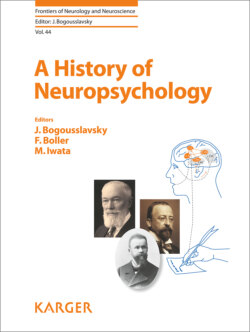Читать книгу A History of Neuropsychology - Группа авторов - Страница 21
На сайте Литреса книга снята с продажи.
Right-Hemisphere Specialization “Objects, Places, Persons, &c.”
ОглавлениеAlong with language disorders being so obvious and debilitating, this elevated view of the left hemisphere may help explain why it took longer to appreciate that the right had powers of its own. A breakthrough came in 1874 [38] when Hughlings-Jackson (Fig. 4) reported that persons with right-hemisphere injuries, but now posterior, had deficits in “recognition of objects, places, persons, &c.” (p 70). Note the similarity in names to Gall’s faculties of “place,” “space,” and “person.” Gall, of course, saw the faculties and their corresponding organs, like those for language, as identical pairs, one to each side.
Fig. 4. John Hughlings-Jackson (1835–1911). Wellcome Library. Public Domain.
Hughlings-Jackson’s second report, in 1876 [39], was especially compelling. His patient Eliza T., 2 months after complaining of headache and “neuralgia,” began making odd mistakes, such as putting her clothes on the wrong side and losing her way in a park she had visited for decades. After being admitted to hospital, more symptoms appeared: an inability to name common objects and mistaking the people around her, for example, calling all the nurses “Annie” (her daughter’s name). She died soon after, and the autopsy showed a tumor in her right temporo-occipital cortex. Hughlings-Jackson called her combination of symptoms – visual disorientation, facial agnosia, and dyspraxia for dressing – “imperception” and proposed that it was as characteristic of posterior right-hemisphere disease as aphasia was of disease of the anterior left.
Further reports came in support. Two examples will serve. In 1895, Dunn [40] described a man with defects in topographical orientation following a right-hemisphere stroke. Dunn posited a “geographical centre” in the right hemisphere for recording “optical images of locality, analogous to (Broca’s region for) speech on the left …” (p 54). In 1905, Lenz [41] described 8 patients with homonymous hemianopia with visual disorientation. Finding that 7 had a left-field defect, Lenz suggested that “the right occipital lobe is perhaps more strongly related to orientation …” (quoted in translation in Benton [36], p 11).
